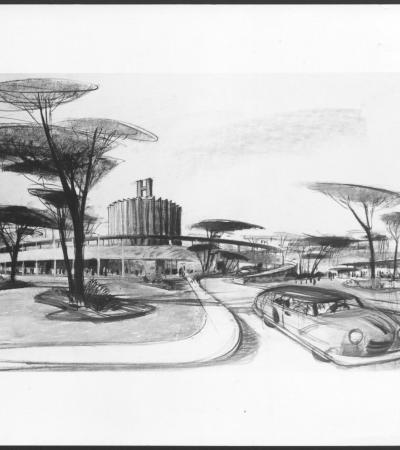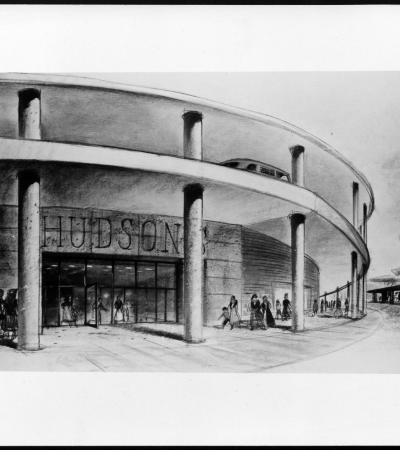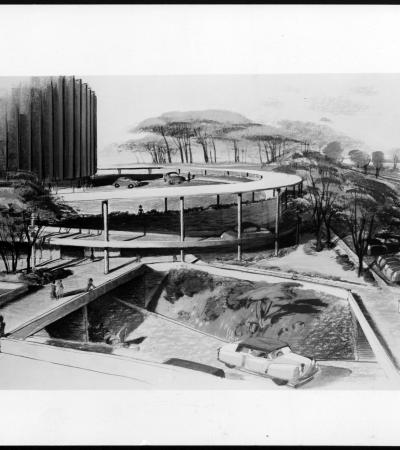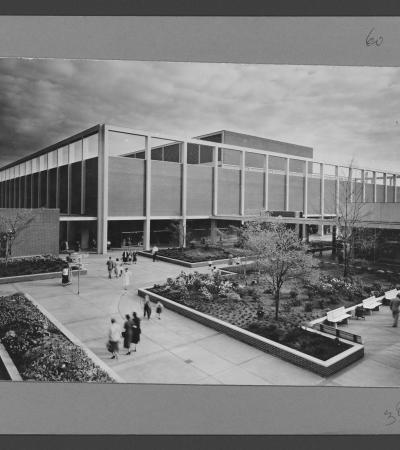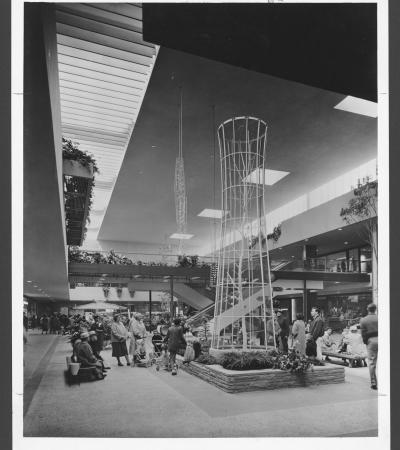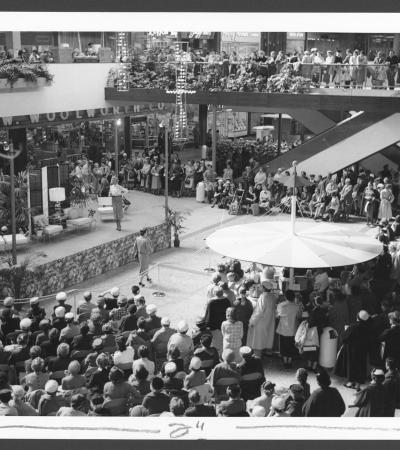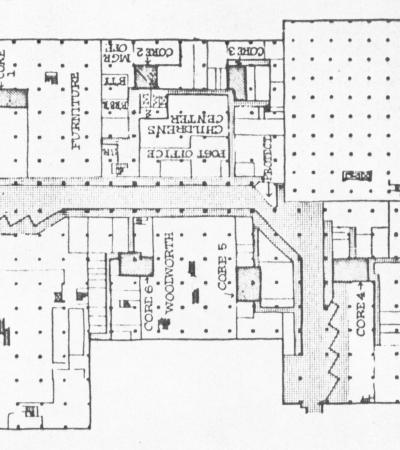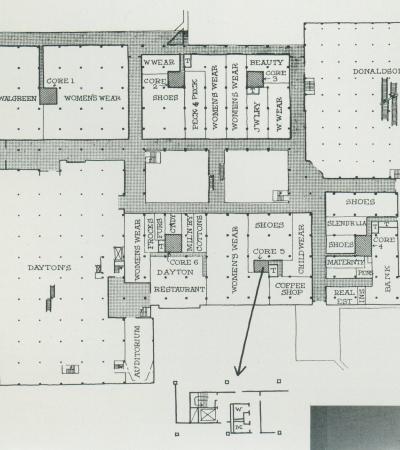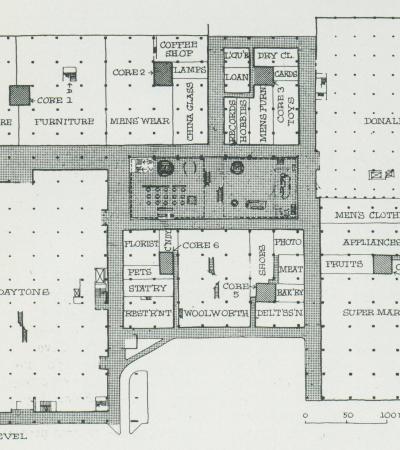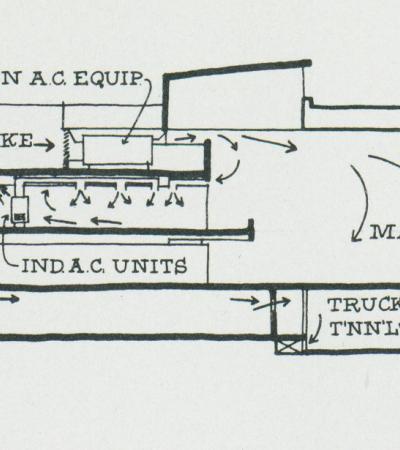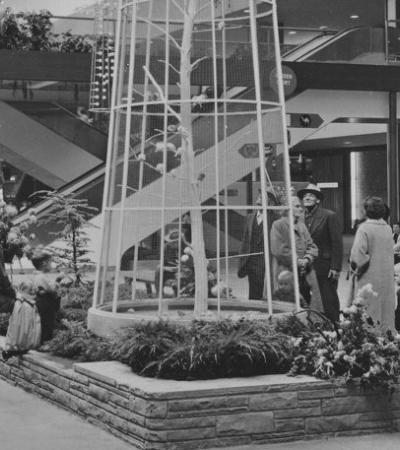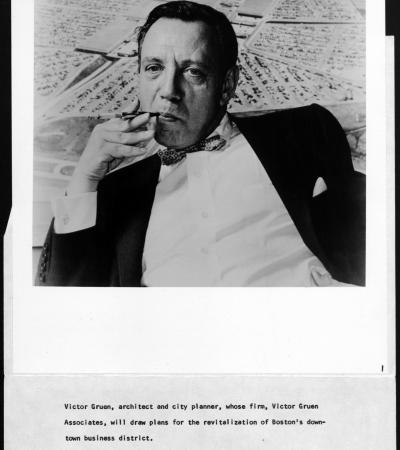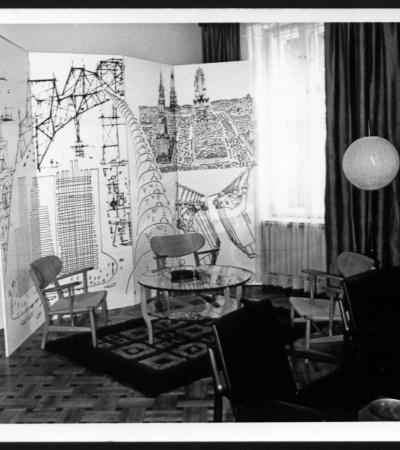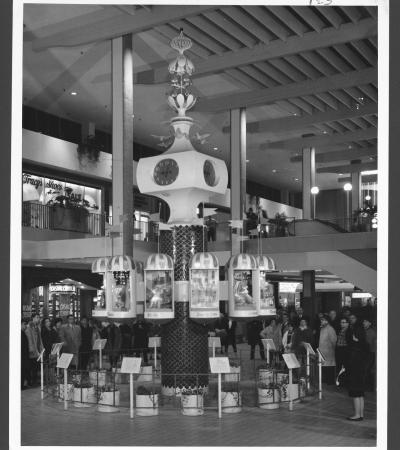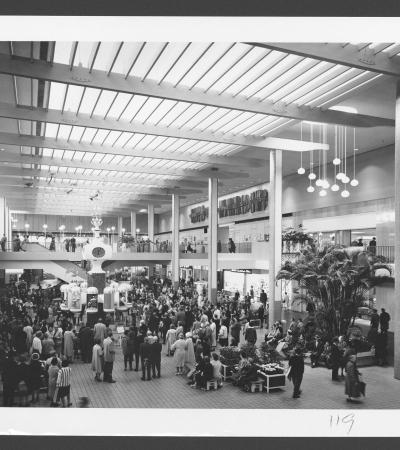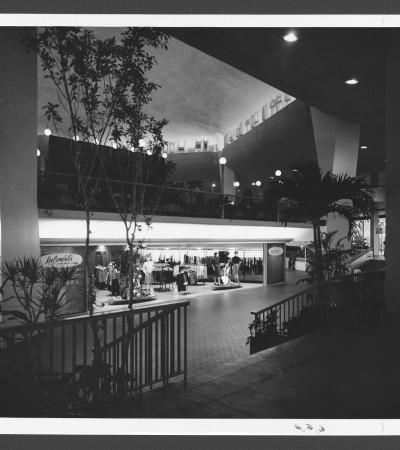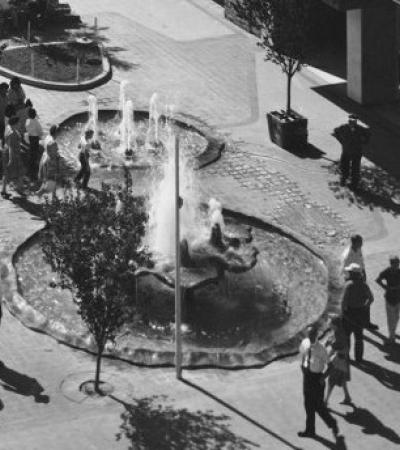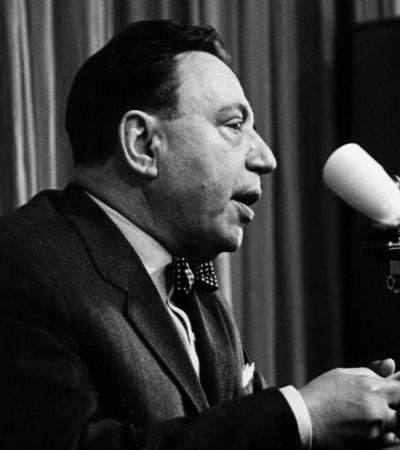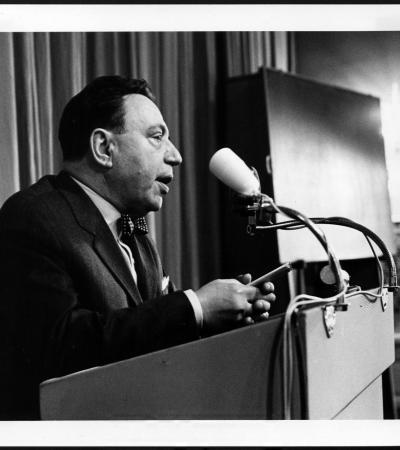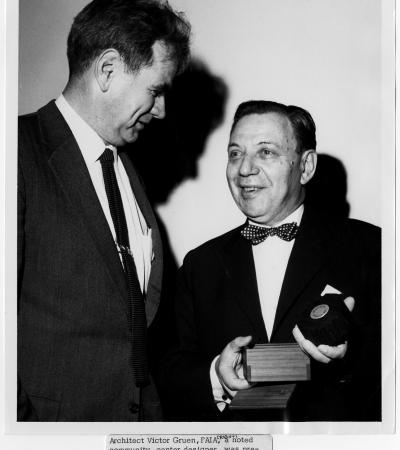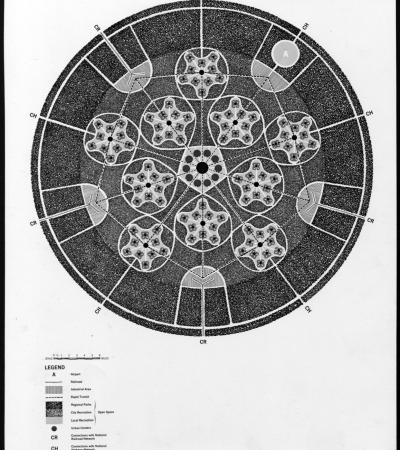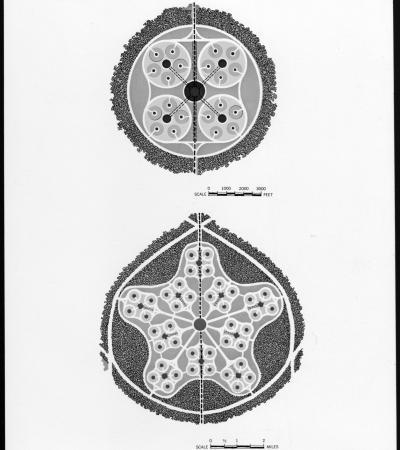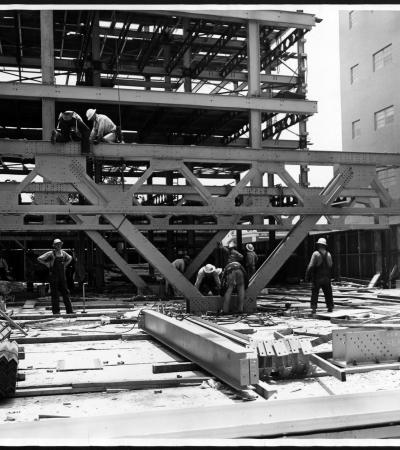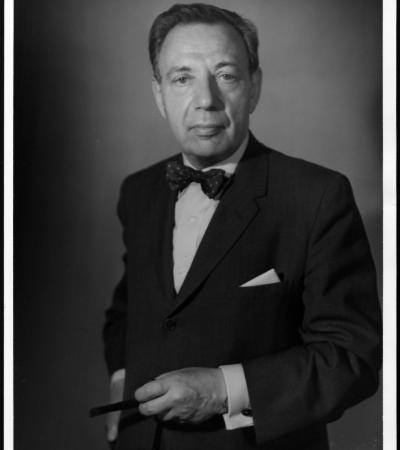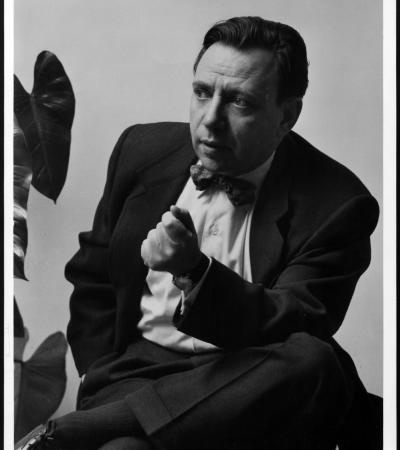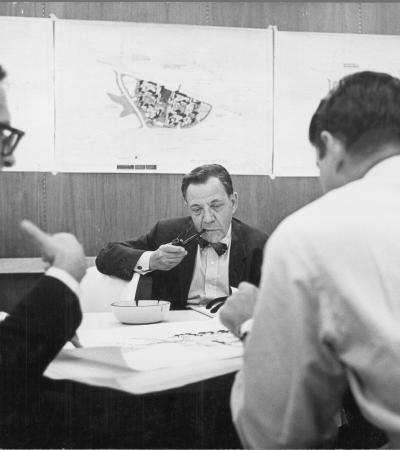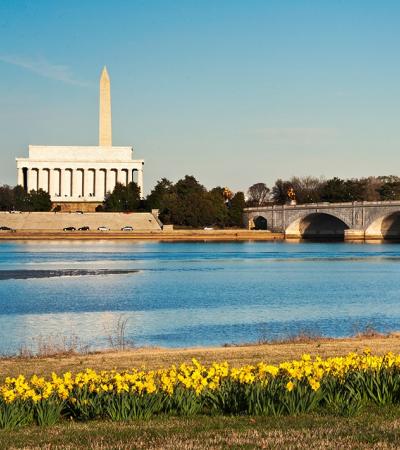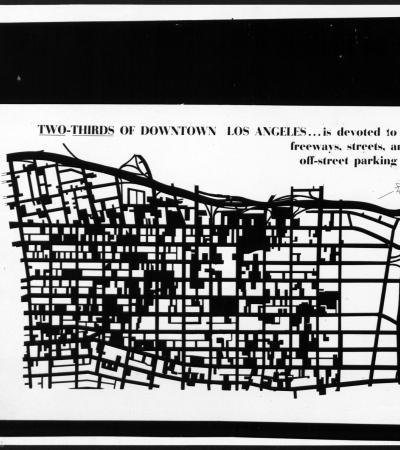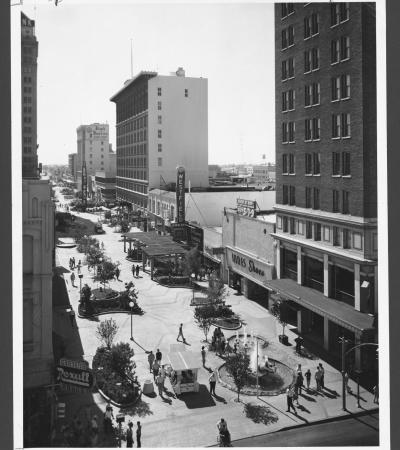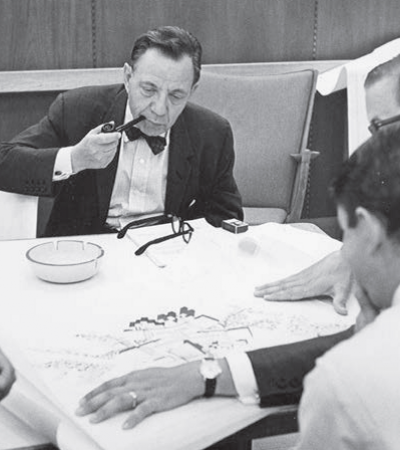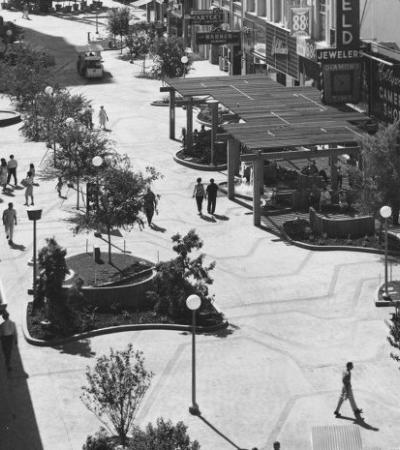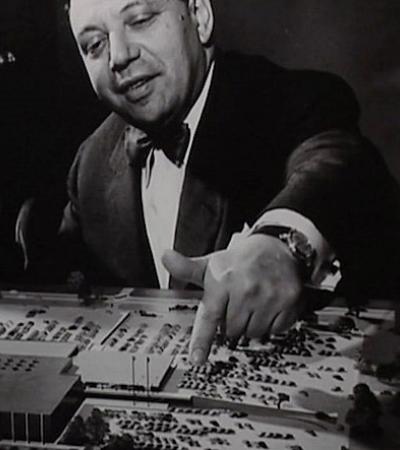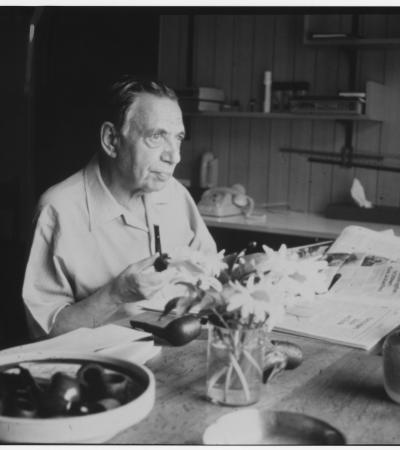Victor Gruen (1903-1980) was an Austrian-born American architect and city planner best known as a pioneer of the shopping mall. He opened his architectural practice in Vienna in 1933 but emigrated to the U.S. five years later after Nazi occupation of Austria. He arrived in New York City with his architectural degree, eight dollars in cash, and no command of the English language.
From this humble start came a distinguished 39-year career in the design of retail structures, which started with his creation of fashionable boutiques and work on renovating several Manhattan department stores.
Following World War II, the United States, after years of depression and global conflict, was primed for major economic expansion. In 1946, just in time, Gruen opened his own firm. Based in Los Angeles, where Gruen had relocated, Victor Gruen Associates employed professionals from all fields of engineering, architecture and planning who became known for their inventive concepts.
Urban decay led to much of the post-war growth arising in new, outlying suburbs. Gruen envisioned the regional shopping plaza becoming the center of commerce in this reconfigured landscape. He meant for the mall to be a communal gathering place where people would shop, sip coffee, and socialize, as he remembered in his native Vienna. By the mid-1970s his office had designed more than fifty shopping malls in the U.S.
Gruen also had many concepts for urban renewal projects that came into focus after the onset of suburbia. He believed that American central cities could be revitalized by constructing expressway loops around downtown areas, routing automobile traffic into parking garages and creating pedestrian-only zones, free of vehicular traffic, on previously-existing streets. Walt Disney was heavily influenced by Gruen's work in his early plans for EPCOT, which was originally designed as a planned city created with urban renewal in mind. After Disney passed in 1966, the plans for the experimental city were scrapped and EPCOT was reimagined as part of the Walt Disney World theme park.
His first downtown redevelopment plan was commissioned by Fort Worth, Texas in 1955, but was never carried out. Kalamazoo, Michigan, Fresno, California and Honolulu, Hawaii implemented parts of Gruen's plans by building open-air pedestrian malls.
By the 1970s, it became clear that no grandly conceived redevelopment scenario could reverse the flight of retail trade from the blighted central city. Gruen never imagined that his socially conscious town plaza would instead contribute to the very suburban sprawl that he despised and to the continued demise of the urban core. Developers were interested in profit instead of a larger vision. Communities did blossom around the new malls, but they were largely uncoordinated developments of gas stations, motels, and wayside stores that Gruen had once characterized as “avenues of horror.”
Gruen became disillusioned and returned to his native Vienna only to find that the mall followed him there as well, and was driving the independent shopkeepers out of business. The mall concept that began in suburban America had proliferated around the globe.
Additional content for this collection can be found in the "Inventory for collection."
Design for Eastland Center, ca. 1950
Gruen's first design for a shopping mall was commissioned by Detroit's J.L. Hudson Company to be located in an eastern suburb of Detroit. The mall was designed with Hudson's as its anchor store. However, the Korean Conflict caused building material shortages and the project was not completed. A more conventional Gruen-designed mall opened on the site seven years later in 1957.
Design for Eastland Center, ca. 1950
Another view of Victor Gruen's original design for Eastland Center.
Design for Eastland Center, ca. 1950
Shown here is the pedestrian overpass by the side of Hudson’s circular store as seen in Victor Gruen's original design. In the background is Hudson's roof parking reached by circling ramps. In the foreground is the lower roadway that carries automobile traffic entering the Center. Trucks were to enter by the same road but were diverted at this point into one of the two freight tunnels which serve the major stores on each side of the oval. All traffic, except pedestrians, was to circle in a one way pattern.
Northland Center in Detroit, Michigan, ca. 1954
As originally built, Northland was an open air pedestrian mall embellished with gardens and sophisticated modern sculpture. It opened in 1954 to much fanfare, and provided Victor Gruen with national prominence. Northland was enclosed in the 1970s. By then Gruen had soured on the mall concept—the sprawl of tacky shops, parking lots, and gas stations that soon surrounded most malls went against his original vision. By 2015 Northland was closed.
Bird cage at Southdale Center, ca. 1956
Victor Gruen and Gruen Associates designed the Southdale Shopping Center in Edina, Minnesota which opened its doors on October 8, 1956. The mall’s temperature-controlled interior was a welcome change for Minnesotans, especially during the long winter months. One of Southdale Center’s signature features was a two-story birdcage, pictured here, positioned in the tropical-themed Garden Court in the center of the mall.
Fashion show at Southdale Center, Minnesota, ca. 1956
One of the most innovative features of the Southdale Shopping Center was the centrally located “Garden Court,” an area approximately the size of a city block bursting with tropical plants and greenery, a sparkling fountain and goldfish pond, a two-story bird cage and art sculptures that provided for an exotic feel. Skylights contributed to the area’s nature-like environment.
Section of Architectural Plans Core 1-6 for Southdale Center, 1956
Diagram that includes furniture store, children's center, post office, Woolworth's, Dayton's, etc.
Section of Architectural Plans Core 1-6 for Southdale Center, 1956
Diagram that includes women's wear, shoes, childwear, and etc.
Section of Architectural Plans Core 1-6 for Southdale Center, 1956
Shown in this diagram for the lower level of Southdale Shopping Center are menswear, Woolworth's, a supermarket, etc. Having a supermarket in a shopping mall may seem like a strange choice in today's culture, but it aligned perfectly with Victor Gruen’s overall concept for the space. Although Southdale became a shopping mall only, Gruen’s original plans were to create a larger community centered around the mall, thus eliminating the need for the suburb’s inhabitants to venture into the city for their needs.
Architectural plans for air flow/heating and cooling systems for Southdale Center, 1956
Diagram of the perimeter heating, main AC equipment, air intake, ind. AC unit, truck tunnel, exhaust system and basement storage of Southdale Center.
Promotional video for Southdale Shopping Center, 1956
The Southdale Shopping Center opened to much fanfare on October 8, 1956 and welcomed 75,000 guests on its first day. The modern parking lot design, the Garden Court, elegant dining options, recreational activities for children, sought-after stores and climate-controlled atmosphere are all features of the mall that are highlighted proudly in this promotional video from 1956. Length: 2 min 9 sec.
Victor Gruen, ca. 1960
Photo caption: "Victor Gruen, architect and city planner, whose firm Victor Gruen Associates, will draw plans for the revitalization of Boston's down-town business district." The caption gives the address of Don Colen of the public relations firm Ruder & Finn, Inc. in New York, NY for more information on the story.
Room at the firm of Victor Gruen Associates, ca. 1960
Modern furnishings shown in meeting room at Victor Gruen's firm.
"Clock of Nations" at Midtown Plaza in Rochester, New York, ca. 1962
The "Clock of Nations" was created by artist Dale Clark and was the centerpiece of Midtown Plaza. Gruen and Associated designed the shopping center, which opened in April 1962 and became the second indoor mall in the nation. The rotating clock held 12 capsules containing puppets representing different nationalities living in Rochester.
Crowds gathered around the "Clock of Nations" at Midtown Plaza, ca. 1962
Gruen's intention when creating this shopping center was to provide a pedestrian-friendly town square for Rochester. He incorporated art (such as the clock), benches, fountains, a four hundred seat auditorium, and a sidewalk café into his design to encourage the type of social mingling he considered essential to urban life. Midtown attracted international attention when it opened and won several design awards.
Randhurst Center, ca. 1962
Randhurst Center was built on the site of one of the last farms in Mount Prospect, a suburb of Chicago. Instead of the typical shopping center built in a straight line between two anchoring department stories, Victor Gruen's design was shaped like a triangle with an anchoring department store at each angle. Additional stores lined the sides of the triangle on two levels. It was built during the height of the Cold War and included a fallout shelter big enough to hold every citizen of Mount Prospect.
Transcript of speech by Victor Gruen at the American Institute of Architects, San Fernando Valley Chapter, 1962
Gruen discusses the impact of modern transportation on urban settings and offers alternatives to create a more attractive and inviting urban life.
Transcript of speech by Victor Gruen to Victor Gruen Associates, 1962
Gruen's presentation to members of Victor Gruen Associates regarding his arguments toward a reinvigoration of modern and postmodern architectural style.
Victor Gruen speaking in Vienna Austria, 1963
Gruen addresses attendees at the opening ceremony of an exhibition prepared and circulated by The Museum of Modern Art and shown in Vienna from June 20 to July 14, 1963.
Victor Gruen receiving an award at Rice University, 1963
Victor Gruen receiving an award from Chairman W.W. Caudill of the Department of Architecture at Rice University for Gruen's contributions to "socially significant architecture."
Drawing of an urban diagram, ca. 1964
Diagram showing an urban plan including an airport, railroad, industrial area, parks, etc. There is a legend in the bottom left corner. Taken from back of the item: "Project: VG Book, Heart of our Cities." Likely this note is referring to the book The Heart of Our Cities: The Urban Crisis, Diagnosis and Cure (1964) by Victor Gruen.
Drawing of urban diagrams, ca. 1964
Diagrams of two different urban plans. There are scales at the bottom of each diagram. Taken from back of the items: "Project: VG Book, Heart of our Cities." Likely this refers The Heart of Our Cities: The Urban Crisis, Diagnosis and Cure (1964) by Victor Gruen.
Construction site of one of Victor Gruen's projects, ca. 1965
Victor Gruen, 1965
Victor Gruen, ca. 1965
Victor Gruen working with his associates, ca. 1965
It might be noticed that all at the table are males. Until 1972 and the advent of Title IX, which forbade gender discrimination in federally funded education programs, most American architecture schools refused to admit women. According to The American Institute of Architects, in 1958, 1 percent of registered architects were women. By 1988 that number had risen to 4 percent and to 13.5 percent by 1999. Women principals and partners at firms grew from 4 percent in 1999 to 16 percent in 2005.
Scenic Easement Development Planning and Potomac River Planning. Includes interview with Victor Gruen included, ca. 1965
NBC TV film with scenic establishment shots, then interviews with various individuals regarding the Scenic Easement Development Planning, Potomac River Plan. Interview with Gruen regarding plans begins at 3:06. Length: 11 min 26 sec.
Schematic plan of Los Angeles downtown, ca. 1965
The text above the grid reads "Two-thirds of Downtown Los Angeles...is devoted to freeways, streets, and off-street parking" Text on the back states that areas in black represent car needs in central Los Angeles, such as streets, parking lots, or garages, and that two thirds of the land in the central Los Angeles will have to be devoted to these needs. Because of a large population and a small amount of land, the text notes that the central area "cannot fulfill the urban functions of a metropolis of 6,000,000 inhabitants."
Fulton Mall in Fresno, California, ca. 1966
This pedestrian mall and urban park in downtown Fresno was created by excluding vehicles from six blocks of Fulton Street as well as some segments of streets that transected Fulton. The mall was designed by Garrett Eckbo as the centerpiece of the plan by Victor Gruen and Associates to transform Fresno’s downtown area.
Victor Gruen International Office film (silent), 1967
Views of the office of Victor Gruen Internation in Vienna, Austria, along with staff members, December 1967.
"Fresno: A City Reborn," 1968
This film is a study of issues in city design, urban sprawl, and an introduction of city redesign in Fresno California. It shows Fulton Mall in Fresno at its height. But the vibrancy was short-lived—within two years, the mall's anchor stores were moving north as Fresno's population spread, which led the city council to make a series of decisions that ultimately undermined Gruen's plan to eliminate sprawl.
Film length: 28 min 48 sec.
Austrian newsreel that includes interview with Victor Gruen in Los Angeles, June 21, 1969
An Austrian newsreel with dialogue in German. Includes interview with Victor Gruen at his Beverly Glen residence in Los Angeles and in his office at Gruen Associates, Austrian Airlines promo. Length: 7 min 49 sec.
Victor Gruen, ca. 1970
Gruen shown after he returned to his native home of Vienna, Austria. In 1968, he returned to Vienna, where he engaged in the gradual transformation of the inner city into a pedestrian zone, of which only some parts were implemented, including Kärntner Straße (the most famous shopping street in central Vienna) and Graben, a famous street in the city center.
